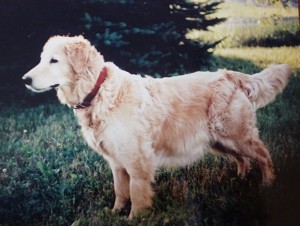I have wanted to write about dogs for quite a while. I am, very definitely, a “dog person,” and I go out of way to interact with dogs anywhere I might meet them. I have had over all of my 64 (soon to be 65!) years only a small, cumulative number of months when I have not had a dog of my own. I can say “Can I say ‘hello’ to your dog?” in five languages! The only thing that I might be more poly-lingual about is ordering glasses of beer or wine! There was a great flurry of evolutionary and genetic papers published this past summer about dogs: very complex stuff, but worth working through to be able to talk about our best friends.
So where did dogs come from?
Genetically there is no doubt that dogs arose from wolves. There has been, however, a great deal of controversy about where and when that dog/wolf split occurred.
A paper published last year (June 1, 2015) in Current Biology analyzed the DNA of dogs and wolves and determined that the split between the two occurred about 30,000 years ago! This very ancient divergence challenged the prevailing notion that dogs developed as a species and bonded with humans about 10,000 years ago just as people were inventing agriculture and giving up their nomadic, hunter-gatherer life style.
This search for the temporal origin of dogs was also the topic for another research group that examined the DNA from dogs that lived 14,000 to 3,000 years ago. This group concluded that there was not just a single deep past origin of dogs. This study published in Science (June 3, 2016) showed that there were two distinct lineages of modern dogs that evolved independently from wild wolf populations. These observations (which placed the divergence of the two dog lines between 14,000 to 6,400 years ago) indicated that dogs were domesticated at two separate times and in two separate places (once in Europe and once in Asia) and that only in very recent centuries have these two lineages been recombined.
So dogs have been with humans since before agriculture, and they were so important to people that they were, and this is without precedence among any of the other animal species that humans have tamed, domesticated twice! To me, this helps to explain why I feel that having a dog around is not a luxury but an absolute necessity!
So how does an organism go from being a “wolf” to being a “dog?” What is the nature of this transformation?
Wolves, like other wild animals run away from or lash out violently when approached by humans. The central cause of this fight or flight reaction is a massive release of stress hormones (especially adrenaline) that then triggers the physical behaviors. The flight distance (the distance at which an approaching human will trigger flight) or the critical distance (the distance at which protective/aggressive behaviors are triggered) that an animal exhibits vary with the animal’s experience, with its environment and also with its genetic makeup. Some individual animals are more tolerant of humans, you can get closer to these individuals and you may even be able to touch them without triggering their stress response! These are the individuals that could be selected to build a “tame” (or “domesticated”) population! Also, young individuals of many species lack the flight or fight stress reaction to people. Possibly selection of “tamable” individuals of a species is actually the selection of individuals who retain the physiological (or emotional) characteristics of their youth!
There were some very famous experiments conducted in Russia back in the 1950’s involving the domestication of another canid, the red fox (Vulpes vulpes). Dmitri Belyaev was the director of the Central Research Laboratory of Fur Breeding in Russia. The silver fox (a variant of V. vulpes) was being bred at the laboratory and Belyaev wondered if he could select for a tamer, more easily handled animal. He had his associates evaluated the foxes in each litter for positive behaviors toward humans up to the onset of their reproductive maturity. Those individuals who were friendly to and calm around people were then allowed to breed. Within a few generations, a larger and larger percentage of the kits were “people friendly,” and soon not only the behaviors but also the physical appearances of the tamed foxes became more and more “dog-like!” The tamed foxes had floppy ears, shorter tails, and wider and shorter skulls. Their coats became curlier and took on a wider array of colors and patterns. The tame foxes also lost the distinctive “musky” smell that commonly occurs in wild foxes. The tame foxes also wagged their tails, and whined and barked like dogs!
Belyaev attributed many of these physical and physiological changes to a decline in adrenaline and other stress hormones and also to changes in neurotransmitter levels in the brain. He had “invented” a new domesticated canid! Possibly a similar selection process, carried out almost inadvertently in the frozen, Ice Age wastes of northern Europe and Asia, went on to facilitate the transition of wolves to human-loving dogs!
This fall there was an article in Scientific Reports (September 29) that looked at some specifics of the genetics that might have been involved in dog domestication. In this study a population of 430 laboratory raised but untrained beagles were presented devices that contained small pieces of food. Some of these devices were easily opened while others were functionally un-openable. The researchers measured the intensity of the orientation of the dogs to human beings in their attempts to get help to open the difficult devices. Some of the dogs, frustrated by these devices turned to supervising humans with very obvious behavioral and auditory signals and “asked” for assistance in obtaining the food treat. Other dogs ignored the human supervisors completely and simply gnawed on and scratched at the food filled device.
Almost half of the dogs in this study fell into one of these two behavioral extremes. Analysis of the DNA of these dogs showed differences in gene markers found on their Chromosome #26. Approximately 30% of the dogs that actively turned to humans for help had very distinctive DNA base patterns in genes that in humans have been associated with many interactive and social behaviors! Possibly, these dogs were genetically predisposed to include humans in their social spheres (an absolute requirement for initial domestication!).
Dogs and dog perceptions have been described in several other, recent research articles. One (in Science August 30, 2016) used MRI scanners to determine how dogs’ brains process both words and emotional intonations. These researchers noted that verbal commands had to be accompanied by appropriate tones of speech in order to stimulate pleasure centers in the dogs’ brains! Another article (in The New York Times (October 10, 2016) described a dog’s sense of smell and compared the detail and importance of the odor map that a dog mentally generates as they move through the world to our own visual map of the world. Dogs create a continuous, three-dimensional matrix of olfactory sensations and orient to and interact with this scent reality in ways that we can only begin to imagine!
So, go out and do something with your dog today! If you need to, just borrow one. Your genes (and their genes) will definitely thank you!






Great information, and I enjoyed the photographic history. You’ve been blessed with some long-lived dogs.
Yay dogs! A subject even closer to my heart than bees! 🙂 Thanks for this summary of recent scholarship of these wonderful beings–and for the sweet photos of your present and past canine pals. Just promised Bernie & Zorra a lunchtime walk. That will do us all some good. And thanks, Paul, for the info about songbird diversification!
I should have mentioned that it’s a heck of a lot easier for birds to diversity because they can fly far distances separated from others of their species. Do you know what the genetic of divergence is between domestic chickens and their ancestor the red jungle fowl of Asia? I don’t have any idea, and I don’t know whether they do (or can) still interbreed. I think there was an article about this in Science some time ago, but I don’t remember it.
Wonderful dogs! My favorite, by sight, is Izzy. I grew up in Los Angeles with a fairly rare Hungarian puli and have never since had a dog I loved so much. My wife had two great danes at the same time (!) when she lived on Mount Washington before I met her.
Something that struck me was how recently the wolf/dog split evidently occurred. I recall reading that article in Science last spring and was surprised.
I know nothing about mammal evolution, but according to the most recent research the great songbird diversification from its origin in Australia began about 33 million years ago and had spread around the world as long as 23 million years ago. The most recent diversification in North American songbirds is said to have occurred during the Pleistocene 1-2 million years ago when populations were divided into separated refugia during glacial advances.
Compared to those time spans, the dog and the wolf must still be much more closely related genetically than I would have thought. Do (or can) dogs and wolves still interbreed viably? If not, I guess this is a tribute to the genetic power of domestication.